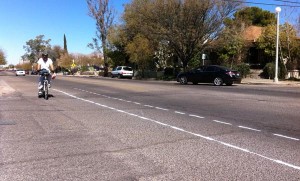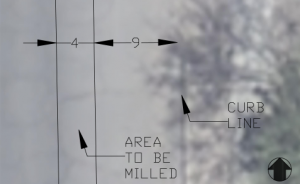
Following up on Monday’s post about bike-only pavement, I asked bicycle and pedestrian program manager Tom Thivener about some of the concerns raised in the comments here.
Thivener said he is aware of some of the maintenance concerns the cutting and replacement of a four-foot section of Fourth Avenue may create, but said they have spoken with the street crew who will be doing the work and asked them to make the transition as smooth as possible.
He said there are hundreds of crews out there doing patches and a lot of them are utility companies, not city crews. He said the quality of the patch can vary.
“There are big cracks out there now,” Thivener said. “Whatever we do, we see at an improvement over what the condition is now. You have 50-year-old pavement that is buckling so I don’t see how it could be any worse.”

Thivener also clarified the placement of the patch. He said the pavement will start nine feet from the curb. They will also place sharrows in the center of the strip of pavement.
Thivener said he doesn’t think the pavement will be a big deal to drivers.
“I don’t think the cars are going to squeal too much about the bikes getting this one improvement,” Thivener said. “I definitely think they will be more vocal about the turn restrictions once they go in.
Update: Here are a few more thoughts from Thivener about the project via email:
1) A year and a half ago the City hosted four public openhouses. We received about a hundred comments at those meetings and via email. The number 1 comment from those meetings was that the pavement between Speedway and University was a deterrent to bicyclists riding on the corridor.
2) Riding on that stretch is simply jarring to a bicyclist. Driving on that stretch in a car with a modern suspension system is much different and is tolerable.
3) The cost for the quick 4 foot fix is roughly $15,000 versus $150,000 to mill the entire 55 foot wide roadway. $150,000 would eat up half of the entire project budget and is therefore out of the question.
4) The neighbors living on the corridor were mailed a summary/description of the improvements coming with the project in 2010, after the last openhouse and after the plans were finalized. Included in the newsletter was a postcard to mail back in if they had issues with particular elements of the project. We received 20 cards back out of 2,200 mailed out. None had issues with the pavement fix.
5) The City performed extensive outreach on this project and I can say that we have support from all the neighborhood associations along the corridor. In fact, this project was initiated by the neighborhoods, who solicited help from the Drachman Institute who formed the concept for the corridor.
6) I wouldn’t call it “bike only pavement”. If it were in a bike lane that would make sense. We’re putting down shared lane markings there for cars will still have the freedom to drive in the 15′ area between the center turn lane and the parking lane curbside. Bikes also have the freedom ride in this shared 15′ lane, however they most likely will position themselves a few feet to the left of the parked cars, hence the decision to place the shared lane markings about 11.5′ from curb and to mill where we expect bikes to ride 9 to 13 feet from curb. I would reserve the term Bike Only Pavement for bike facilities that are completely separate from car traffic, which we have over 150 miles of in this region.

Quoth Tom in the story:
“I don’t think the cars are going to squeal too much about the bikes getting this one improvement,” Thivener said. “I definitely think they will be more vocal about the turn restrictions once they go in.
To which I say:
Tom, I’d like to introduce you to my neighbors. They’re already squealing about this project. And it hasn’t even begun yet.
I can’t wait to hear what the neighbors have to say once this thing gets underway. If they don’t resent bicycling around here now, I think they will soon.
OTOH, I know more than a few people who moved into this area because it borders 4th Avenue and is close to the UA and Downtown. And many of these recent arrivals are happy to use their bikes to transport themselves hither and yon.
So, our neighborhood carhead vs. bikehead discussions will be very interesting.
I mis-read what it says on the illustration – Area to be Milled – the first time.
There will honking and gesturing. I strongly urge signage asserting bicyclists’ right to use the full lane in this scenario. I don’t believe motorists are going to
differentiate the meaning of sharrows and other pavement bicycle markings; assuming they notice them at all.
eeee
I kind of like the placement of it. The debris will collect against the curb and leave the bike lane clean.
To the complainers, isn’t it more annoying to get stuck behind a bike when we ride down the center of the street? Playing dodge isn’t annoying to you but giving us a nice little lane where we won’t bother anyone is? I don’t get it.
The elephant in this room is the price of gas: It’s going up. Again. Not to mention the costs of purchasing and owning a car. Also headed up.
Specially designed facilities are all very nice, but I think that incentives still matter. Rising costs of gasoline and car ownership will do more to get people on bikes than anything else. I saw this during the energy crises of the 1970s, and here we are again.
Check the post for an update with more of Thivener’s thoughts.
Oh, I was under the optimistic assumption that this surface improvement was for the entire length of the 4th Ave.-Fontana bike boulevard….not just Speedway to University. I agree, it needs to be done-totally. Although Tom T. wouldn’t call it “bike only pavement”, I believe when motorists turn onto this historically rough section and see a strip of smooth asphalt with bike markings on it, THEY will call it “bike only pavement”.
I’m disappointed, actually, that this surface treatment isn’t scheduled for the entire length of the boulevard. I wonder if the city isn’t trying to pull this thing off too much on the cheap and therefore affecting its acceptance.
The original article had the University to Speedway limit on the new pavement, though it was a few paragraphs in.
http://tucsonvelo.com/news/city-experimenting-with-bike-only-pavement-upgrade/5901
[…] list is getting the Fourth Aveneue/Fontana bicycle boulevard finished and determining whether the pavement fix for Fourth Avenue will […]
[…] list is getting the Fourth Aveneue/Fontana bicycle boulevard finished and determining whether the pavement fix for Fourth Avenue will work.He is also hoping to find alternative streams of funding to proactively […]
[…] began working on the bike-specific pavement upgrades on the Fourth Avenue bike boulevard […]
[…] of the most unique aspects of the bike boulevard project is the repaving of a three-foot wide section of the street between Speedway Boulevard and University […]